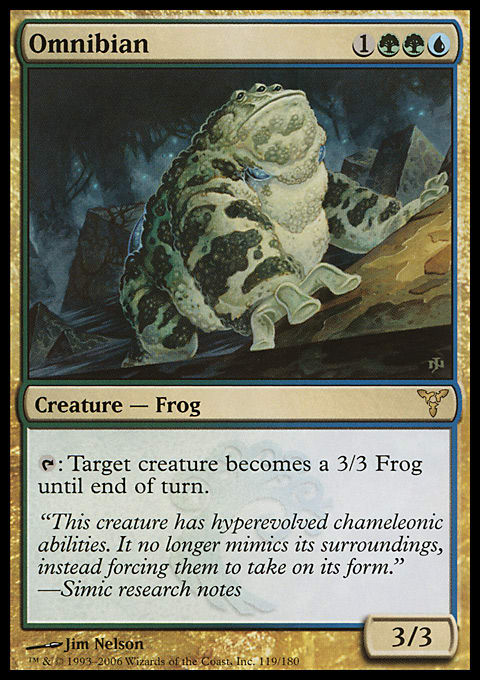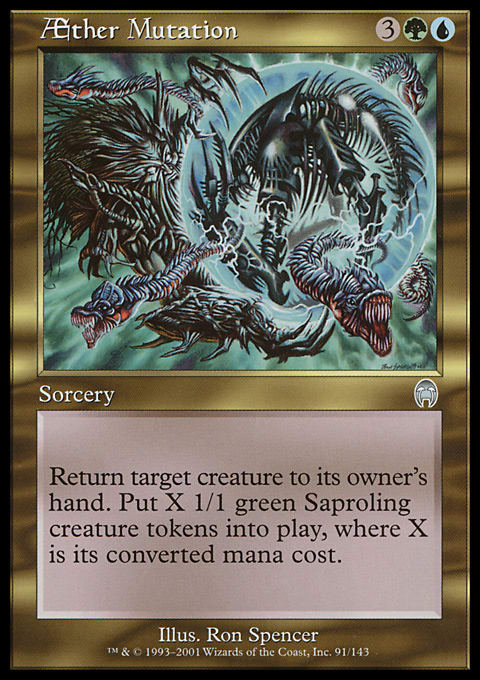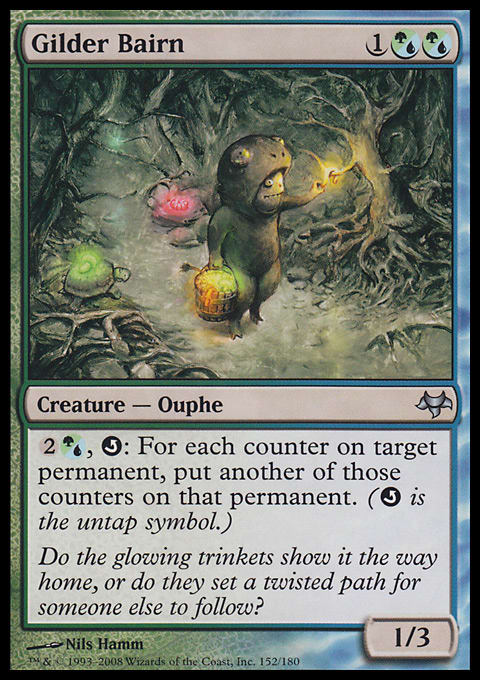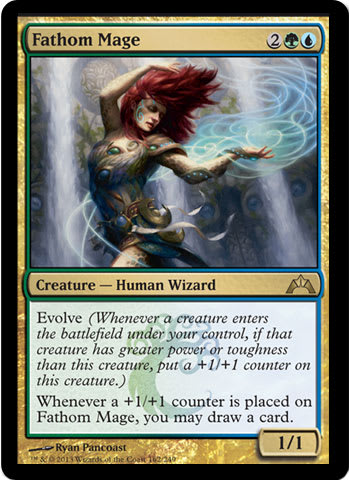Creation or evolution? For those who want to create their own evolutionary paradigm, Simic lets you design as intelligently as you like. Put on your lab coat, and follow me—and try not to step in the puddles of goo.
Strengths
- Speed – I love playing stuff like Cultivate into Explosive Vegetation, but if I can’t get the green acceleration, my second-favorite early play is Ponder into Serum Visions. That’s even more fun than casting Dark Rituals and Sol Rings. Playing Simic means not sweating the early plays.
- Growth – Green grows your mana base, blue grows your hands, and both colors also have different ways to grow your board. Graft and evolve exemplify this kind of philosophy, and the contrast between Izzet’s spells and Simic’s slimy things is also clear. As a rule, Simic decks don’t run out of cards, and they can cast anything in their hands, and the more time you give them, the more they can establish board dominance.
- Transformation – Sometimes, it seems that Simic can do whatever it wants—cards such as Biovisionary, Biomantic Mastery, and Biomass Mutation all feel like things other colors couldn’t possibly do—which makes it the hardest guild to pin down, but a lot of it is about transformation. Omnibian and Cytoshape transform creatures into other creatures (and so do Pongify, Ovinize, Lignify, and a few others), and the new Hydroform even transforms a land into a creature. Sometimes, you might miss black’s ability to transform a live critter into a dead one, but Simic’s style is unique and powerful—and even more powerful because it is so often unexpected.
Weaknesses
Simic doesn’t have much removal or sweepers of its own—the three other colors tend to receive card advantage by removing their opponents’ cards en masse, but Simic mainly does it through expanding its own resources.
Also, Simic doesn’t have many ways to regrow resources it has lost. If the petri dish is wiped clean, a Simic deck may not have enough time to repeat the experiment. To solve this problem, you have to balance the desire to combo off or grow your forces with a healthy dose of prevention and protection (not easy for many Johnnies to do). Green has its own force protection options, but blue brings a lot to the table here. Consider lesser-played counterspells such as Envelop, Muddle the Mixture, and Mystic Denial— the sorceries are the ones that will cause you the most trouble. The biggest problem for decks built around mechanics such as graft, evolve, and proliferate is that, while you might be able to regrow lost cards, there’s no way to bring back lost counters.
Hidden Gems
Aether Mutation – As a black mage, I prefer killing to bouncing, but this is fantastic tempo. Those token critters can clog the ground for ages or just finish the game with an Overrun or Biomass Mutation.
Coiling Oracle – This is one of the best 2-drops in the game, often better than Sakura-Tribe Elder. How many other 1/1s can you hit with a kicked Rite of Replication and still feel that you got your mana’s worth?
Cold-Eyed Selkie – Ophidian variants are a dime a dozen, but this one draws you a card for each point of damage it deals. Pair it with a Sword, and you might not need another draw spell for the rest of the game.
Fable of Wolf and Owl – It’s card advantage comes in many forms, and a body (even a 2/2) is always valuable, no matter how late in the game. I’ve recently come to appreciate Sword of Body and Mind more because of the value I can generate from a 2/2 Wolf token, and Fable can generate even greater advantage.
Gilder Bairn – Everything that's good about Doubling Season is good about Gilder Bairn—except it doesn’t cost $25. Counter advantage is harder to measure than card advantage, but it has significant value that shouldn’t be underestimated; if it’s worth spending a card to put 5 counters on a creature, a creature that can rack up dozens of counters over the course of a game is a real bargain.
Lorescale Coatl – Edric’s best friend, this Coatl can grow big in a hurry, especially with blue bringing all kinds of instant-speed card-draw to the table; a card like Blue Sun's Zenith, already a must-have in any deck that can run Boundless Realms, starts to look a lot like Howl from Beyond. There’s actually another Coatl that would have made this list, but I was embarrassed that I don’t know what a Coatl is, so I’ll let you find it for yourself.
Nulltread Gargantuan – I was one of the people badmouthing this when it first came out, but recently, my friend Read played it in his Momir Vig, Simic Visionary deck. Before I could say, “Why the hell are you playing that piece of crap?” I realized it is a brilliant play in a lot of Simic builds. Whether you're generating double value from a 187 creature such as Acidic Slime, giving yourself another chance to tutor with Momir Vig, or reloading a Vigean Hydropon for more graft and evolve shenanigans, the Gargantuan gives better value than standard card-advantage theory suggests.
Snakeform – Anything that allows a Coiling Oracle to trade with Avacyn, Angel of Hope or Akroma, Angel of Wrath has to be good.
Spitting Image – This was great value before Return to Ravnica brought us populate . . . now it’s just ridiculous. Go pick some up!
Trygon Predator – These cost three dollars apiece because of their value in tournament formats, but don’t let that deter you from getting your hands on a few copies. Like Aura Shards, some decks just can't recover from a third-turn Predator.
Yavimaya's Embrace – It costs twice as much as Control Magic, but this is Commander—you aren’t trying to steal a 3-drop, you’re trying to grab a Praetor, Primordial, or Eldrazi, so the cost shouldn’t concern you too much. Instead, focus on the way the Embrace helps your creature to outclass everyone else’s. I’m looking forward to getting my hands on a 10/10 trampling Avacyn; what targets does your metagame present?
Meet the Boss
Crap/Fair to Middlin’
Simic doesn’t do boring.
Just Johnnyable
Experiment Kraj – The first step of building a Kraj deck is putting counters on your coolest creatures. The second is putting counters on your opponents’ creatures and exploiting their abilities. But the really crazy stuff happens when you creaturize and counterize noncreature permanents. Get Karn to animate a Nevinyrral's Disk, stick a counter on it, and then tap your Experiment Kraj to blow up the world. Sure, it’s a lot of hoops to jump through, but jumping through hoops is what being a Johnny is all about, and the kind of versatility you get can make for a very threatening deck.
Momir Vig, Simic Visionary – Tutoring and drawing are among the most powerful abilities in Magic, and Momir Vig gives you both of them in one powerful cockroach. There aren't many problems that these colors can't solve in creature form, especially when they get to chain one into another and another and another . . .
Powerhouses
Edric, Spymaster of Trest – When I told folks on Twitter that I was going to build an Edric deck, I didn’t get as many ideas as I was hoping for; instead, I found a lot of people complaining that Edric was too powerful and painful to play against. According to an excellent introduction to French EDH, he was also the top commander in 2012. It’s obvious what’s happening in one-on-one: Edric turns all your creatures into Thieving Magpies with no drawback. However, in multiplayer, there’s a lot more going on. First, Edric changes your opponents’ cost-benefit calculations, making you a less attractive target at first. But then, your opponents are either outdrawing you exponentially or they realize that you have made Edric asymmetrical, and you start to look more threatening, thus outweighing the strategic benefit that Edric initially offered.
Bottom line: He’s undeniably powerful, and he’s one of the most strategically interesting legends in the game, but I wouldn’t consider him inherently broken. That being said, if you want to break a commander, the intersection of green and blue is a good place to start, especially given Wizards of the Coast’s obvious hard-on for Simic.
Prime Speaker Zegana – Worst-case scenario, she is a 1/1 who draws you a card—strictly worse than Coiling Oracle. Best-case scenario? She might be the best commander in the game. Ryan Bushard put it best in a recent article on Gatecrash cards in Standard: “Very few plays scare me as much as turn-five Thragtusk into turn-six Zegana.” In Standard, that is living the dream, and in that case, Zegana would be a 6/6 for 6 who draws you six cards—easily on the short list for best commander ever made.
But I can guarantee you that you’re going to see better plays than that in the coming weeks. Mighty Emergence into Simic Sky Swallower into Zegana and draw nine? Nice! Primordial Hydra into Zegana and draw eleven? Sounds great! Riptide Mangler into Equipment into Zegana and draw as much as you like? That either sounds like power creep or a hell of a lot of fun, depending on which end of the gun you're looking at.
Simic Sneakiness
Simic is the Johnniest guild of all, which makes building your first Simic deck a pretty daunting challenge. Here are some ideas to get you started:
- Evolve – A wide-open Johnny mechanic, I’m sure you’ll have fun pushing this as far as it can go, and the vast range of +1/+1 counters throughout Magic’s history means there are a lot of different directions to go.
- Quickdraw – Simic has unrivalled potential for drawing cards, and that isn't a bad place to start your deck-building. Sure, drawing cards isn't usually a win con as such, but when you draw a couple of dozen cards, you should be able to find something helpful. The overlap between draw and huge creatures helps—Sturmgeist, Maro, and of course Zegana—is a good place to start.
- Bouncy Castle – There are a ton of cards that force people to return cards to their hands or even put them on top of their libraries. Blue has most of it, obviously, but there are also artifacts (Umbilicus, Blood Clock, Crystal Shard, Erratic Portal), and green spells like Plow Under, Fallow Earth, and Stunted Growth. But green’s ramp is the key, allowing you to recover much more quickly from an Evacuation or Devastation Tide than anyone else.
- Snakes – Yay snakes!
Confession time: I have had decks for nine of the ten guilds for quite some time, but Simic was the last one. Here is a little something I whipped up recently (meaning last week) but haven't tested extensively. So far, it looks like a hell of a lot of fun, but I’ll let you know how it goes in the real world.
"Simic Commander"
- Commander (0)
- Creatures (34)
- 1 Acidic Slime
- 1 Aether Adept
- 1 Anurid Scavenger
- 1 Augury Owl
- 1 Bellowing Tanglewurm
- 1 Caller of the Claw
- 1 Clone
- 1 Coiling Oracle
- 1 Dryad Sophisticate
- 1 Elven Warhounds
- 1 Fangren Firstborn
- 1 Gurzigost
- 1 Indrik Stomphowler
- 1 Invisible Stalker
- 1 Living Hive
- 1 Lorescale Coatl
- 1 Man-o'-War
- 1 Maro
- 1 Mist Raven
- 1 Patagia Viper
- 1 Simic Sky Swallower
- 1 Sylvan Ranger
- 1 Viridian Shaman
- 1 Wake Thrasher
- 1 Weatherseed Treefolk
- 1 Winged Coatl
- 1 Wonder
- 1 Masticore
- 1 Molten-Tail Masticore
- 1 Phyrexian Revoker
- 1 Razormane Masticore
- 1 Walking Atlas
- 1 Alexi, Zephyr mage
- 1 Centaur Omenreader
- Spells (29)
- 1 Fresh meat
- 1 Nature's Claim
- 1 Aether Mutation
- 1 Distortion Strike
- 1 Explore
- 1 Farseek
- 1 Overrun
- 1 Ponder
- 1 Rain of Thorns
- 1 Rampant Growth
- 1 Serum Visions
- 1 Sleep
- 1 Stomp and Howl
- 1 Beastmaster Ascension
- 1 Chamber of Manipulation
- 1 Dissipation Field
- 1 Equilibrium
- 1 Fable of Wolf and Owl
- 1 Favor of the Overbeing
- 1 Gutter Grime
- 1 Rancor
- 1 Seal of Primordium
- 1 Vow of Flight
- 1 Vow of Wildness
- 1 Yavimaya's Embrace
- 1 Darksteel Plate
- 1 Empyrial Plate
- 1 Swiftfoot Boots
- 1 Venser's Journal
I’m trying to put all of my decks online with our friends at TappedOut.net, so you can check this out and play around with it. A couple of things to notice here that might help you with your own Edric decks:
- Mana fixing in the 2 slot (instead of the more common Cultivate and Skyshroud Claim) can ensure that you hit Edric on time every time.
- There are a lot of ways to gain from drawing cards beyond the predictable Sturmgeist, Soramaro, First to Dream, and Psychosis Crawler; check out the original Maro and all three Masticores.
- There are more out-of-the-box card choices available to Simic than any other guild.
- In Commander, Clone variants can often make up for the lack of actual creature kill.
- All of this goodness is possible even without complete access to Gatecrash cards; I have to say, I’m really looking forward to playing Simic!





























